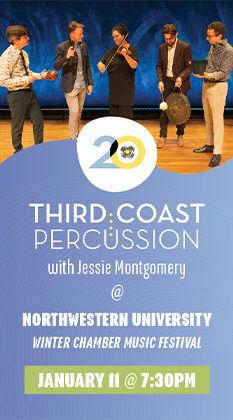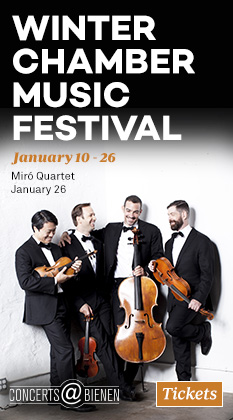Ensemble Correspondances brings the court of Louis XIII to Logan Center

On Friday evening, the University of Chicago’s Logan Center became the Louvre Palace, as Ensemble Correspondances performed music from the court of Louis XIII in a concert titled “Les Plaisirs du Louvre.”
If this music is unfamiliar to you (coming one Louis too early), you’re not alone. Friday night’s rarities in this UChicago Presents event—by such composers as Antoine Boesset, Louis Couperin, and Étienne Moulinié—are a specialty of the Ensemble, for whom they are unearthed and arranged by Sébastien Daucé, the artistic director, conductor, and keyboardist. Because these pieces do not circulate widely outside of Daucé’s editions, the Ensemble has a virtual monopoly on them.
The program consisted of vocal and instrumental excerpts from court ballets and airs de cour, which are the French equivalent of Italian madrigals. Unlike the latter, airs de cour are strophic rather than sung-through, straightforwardly melodious rather than ornate, with dance-like rather than speech-like rhythms.
This repertoire’s potential disadvantage is the lack of text-painting, which singers of 17th-century music otherwise rely upon to create expressive dabs of color. Without such descriptive passages, each strophe can sound much like the next one.
This problem was solved by Daucé’s arrangements, which generated endless variety. The Ensemble’s ten vocalists and eight instrumentalists were mixed together in an assortment of combinations both across and within pieces.
Most often, the songs were sung by all the vocalists. But Daucé arranged Boesset’s “Segua chi vuol iniquo Amore” and “Ce roi vainqueur de nos malheurs” for quartet and quintet respectively, adding a touch of intimacy to what were otherwise rather grand proceedings.
Daucé’s arrangements also allowed for brief solo spotlights for some of the instrumentalists. A highlight of these was sensitive theorbo work by Thibaut Roussel in Pierre Guédron’s “Quels tourments rigoureux” and Boesset’s “Noires forets, demeures sombres”—with Roussel’s varied rhythm choices underlining certain vocal phrases, without distracting from the singers. Also notable was a wistful solo from gambist Mathilde Vialle in Moulinié’s “Concert de différents oyseaux.”
Many of the vocal works feature alternations between a soloist and the chorus. The majority of solos were passed between two of the Ensemble’s sopranos, Caroline Weynants and Perrine Devillers. The natural differences in their timbres—Devillers’s purer and Weynants’s more vibrant—gave each of their strophes its own personality. Daucé also occasionally turned solo strophes into duos by having one of the bass singers double the continuo.
Although the Ensemble plays period instruments, their style was sweeter than your average period group. They lacked the tart accents and incisive phrasing that gives most historically-informed performances their pithiness. The Ensemble’s phrasing was much smoother, their tone warmer, despite the requisite minimal vibrato. Even when their articulation was crisper—as in the concert’s most rhythmic pieces, such as Moulinié’s “Air de la Ridicule”—it added buoyancy rather than sharpness.
Throughout their performances, the Ensemble provided subtle dynamic inflections, while avoiding extremes. Such nuances could be on the word-to-word level, as in Boesset’s “Concert en dialogue d’Orphée et sa troupe, et des Hamadriades qu’ils attirent”; or it could be from strophe to strophe, as in the church choir-like delivery of the conclusion of the same composer’s “David disgrâcié.”
The University of Chicago Presents season will conclude with a series of premieres performed by the Grossman Ensemble, 7:30 p.m. May 20 at the Logan Center. chicagopresents.uchicago.edu
Posted in Performances

